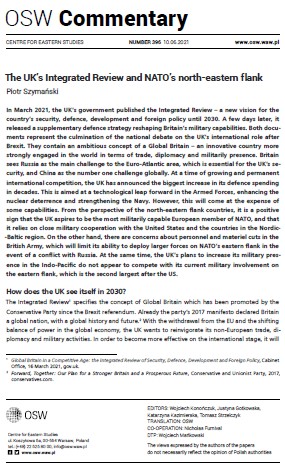The UK’s Integrated Review and NATO’s north-eastern flank
The UK’s Integrated Review and NATO’s north-eastern flank
Author(s): Piotr Szymański
Subject(s): Government/Political systems, International relations/trade, Security and defense, Military policy, Political behavior
Published by: OSW Ośrodek Studiów Wschodnich im. Marka Karpia
Keywords: NATO’s north-eastern flank; UK; British Army; military alliances and partnerships;
Summary/Abstract: In March 2021, the UK’s government published the Integrated Review – a new vision for the country’s security, defence, development and foreign policy until 2030. A few days later, it released a supplementary defence strategy reshaping Britain’s military capabilities. Both documents represent the culmination of the national debate on the UK’s international role after Brexit. They contain an ambitious concept of a Global Britain – an innovative country more strongly engaged in the world in terms of trade, diplomacy and militarily presence. Britain sees Russia as the main challenge to the Euro-Atlantic area, which is essential for the UK’s security, and China as the number one challenge globally. At a time of growing and permanent international competition, the UK has announced the biggest increase in its defence spending in decades. This is aimed at a technological leap forward in the Armed Forces, enhancing the nuclear deterrence and strengthening the Navy. However, this will come at the expense of some capabilities. From the perspective of the north-eastern flank countries, it is a positive sign that the UK aspires to be the most militarily capable European member of NATO, and that it relies on close military cooperation with the United States and the countries in the Nordic--Baltic region. On the other hand, there are concerns about personnel and materiel cuts in the British Army, which will limit its ability to deploy larger forces on NATO’s eastern flank in the event of a conflict with Russia. At the same time, the UK’s plans to increase its military presence in the Indo-Pacific do not appear to compete with its current military involvement on the eastern flank, which is the second largest after the US.
Series: OSW Commentary
- Page Count: 6
- Publication Year: 2021
- Language: English
- Content File-PDF

